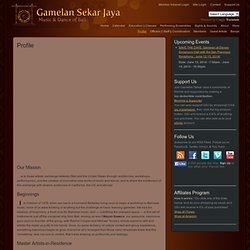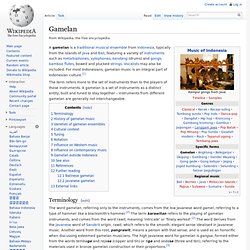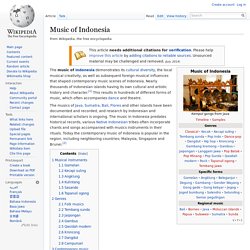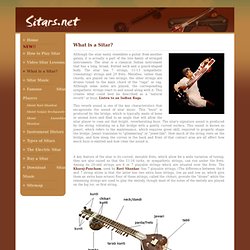

Indonesian gamelan medley from Java, Sunda and Bali. Forging gamelan in Central Java. Detailed: A craftsman works to finish a gong in Surakarta, Central Java.

Gongs take the longest to finish of a gamelan set because it takes five days to form the shape alone. Unlike previous days, the house of Saroyo, an empu or master craftsman of gamelan, saw no hammering of metal or burning fires one Saturday morning. Workers in his gamelan workshop termed a besalen in Wirun village in Sukoharjo, Central Java, were busily preparing offerings in the form of chicken, cone-shaped rice, water steeped in flower petals and incense, among others. Saroyo said a big undertaking would begin that Saturday Pahing (the second day of Java’s five-day week), seen as a “fortunate day”.
That undertaking was the crafting of a full set of gamelan instruments, which in the tradition of Javanese society is marked by a ritual. “The ritual is called Gongso Ageng, a ceremony to appeal for divine blessings so that the craftwork will progress safely and smoothly,” Saroyo said. “Today the situation has changed. Indonesia Needs the Harmony of the Gamelan. Bramantyo Prijosusilo The gamelan orchestra in its different forms is indigenous to many parts of the archipelago and once was so much a part of community life that most villages, in Java at least, would be the loving caretakers of at least one set of instruments. Poor villages had small sets, forged out of iron; wealthy villages had bigger ones, forged of bronze.
The best and biggest sets were kept in the palaces. Since the misty past when metal work was considered akin to magic, gamelan sets have been handed down through generations. Many were believed to have special powers and certain sets are to this day only played on auspicious occasions, such as during the Sekaten ceremony to celebrate the birthday of the Prophet Muhammad in the palace of the sultan of Yogyakarta. Gamelan Ensembles. Bates College Gamelan Orchestra. Vocalist Accompanies Bates College Gamelan Orchestra. History. Gamelan Sekar Jaya. Biography/Profile. Our Mission.

Gamelan Sekar Jaya - Work Sample - 2007. Gamelan Ensembles. Gamelan. A gamelan is a traditional musical ensemble from Indonesia, typically from the islands of Java and Bali, featuring a variety of instruments such as metallophones, xylophones, kendang (drums) and gongs; bamboo flutes, bowed and plucked strings.

Vocalists may also be included. For most Indonesians, gamelan music is an integral part of Indonesian culture.[1] The term refers more to the set of instruments than to the players of those instruments. A gamelan is a set of instruments as a distinct entity, built and tuned to stay together – instruments from different gamelan are generally not interchangeable. Terminology[edit] Music of Indonesia. The music of Indonesia demonstrates its cultural diversity, the local musical creativity, as well as subsequent foreign musical influences that shaped contemporary music scenes of Indonesia.

Nearly thousands of Indonesian islands having its own cultural and artistic history and character.[1] This results in hundreds of different forms of music, which often accompanies dance and theatre. Musical instruments[edit] Balinese gamelan performance. SambaSunda music performance, featuring traditional Sundanese music instruments such as kecapi, suling, and kendang. The musical identity of Indonesia as we know it today began as the Bronze Age culture migrated to the Indonesian archipelago in the 2nd-3rd century BC.[3] Traditional musics of Indonesian tribes often uses percussion instruments, especially gendang (drums) and gongs.
Gamelan[edit] With the arrival of the Dutch colonizers, a number system called kepatihan was developed to record the music. Kecapi suling[edit] Main article: Kacapi suling. Bali & Beyond Educational Resources. Sitar - classical Indian instrument, sitar description, tuning and adjustments of sitar. Although the sitar easily resembles a guitar from another galaxy, it is actually a part of the lute family of stringed instruments.

The sitar is a classical Indian instrument that has a long, broad, fretted neck and a gourd-shaped body. The sitar has 7 strings, 11-13 sympathetic (resonating) strings and 20 frets. Melodies, rather than chords, are played on two strings; the other strings are drones tuned to the main chord of the "raga" or rag. Although some notes are played, the corresponding sympathetic strings react to and sound along with it. This creates what could best be described as a "natural reverb" or buzz. This reverb sound is one of the key characteristics that encapsulate the sound of sitar music.
The Gamelan Music Of Indonesia. Indonesia – Gamelan: From Palace To Paddy Field – World Music Network – Guide To World Music. The shimmering sounds of the gamelan have fascinated and delighted Western visitors to Indonesia for half a millennium.

The structural complexity of the music and its sonorous and ethereal sound have inspired twentieth-century composers such as Debussy, Britten and John Cage, and in recent years there’s been an enthusiastic growth in playing in gamelan ensembles in the West. A gamelan has been described as “one instrument played by many people”. It is essentially an ensemble of tuned percussion, consisting mainly of gongs, metallophones (similar to xylophones, but with metal instead of wooden bars) and drums; it may also include singers, bamboo flutes and spike-fiddle. In Indonesia the ensembles and their sounds are diverse, ranging from Central Java’s bronze court gamelans to the bamboo village orchestras in Bali. The largest bronze gamelans in Indonesia are found in Central Java. Today, nearly ninety percent of Java’s population is Muslim. Life is changing rapidly in Java. Gamelan (Indonesian orchestra.